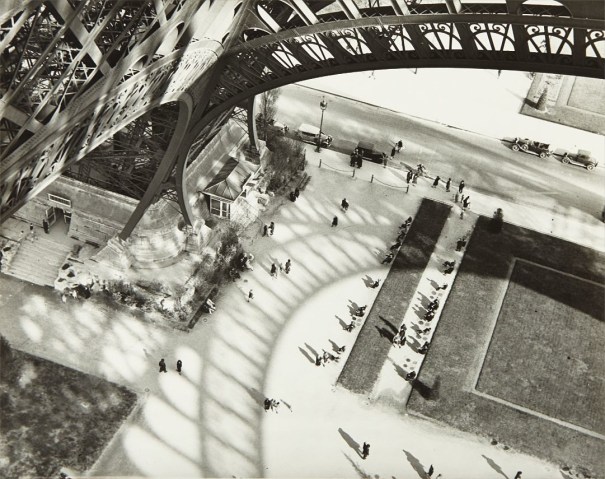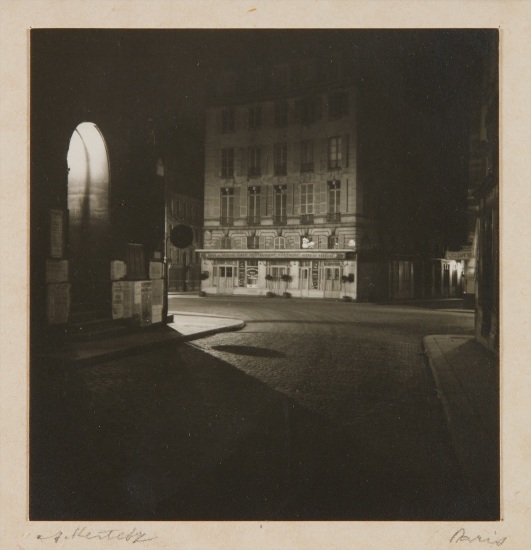PROPERTY OF THE LARRY N. DEUTSCH COLLECTION, CHICAGO/TUCSON André Kertész Distortion #6, Paris 1933 Gelatin silver print, printed 1933 by the artist in Paris from the original glass plate negative. 9 1/4 x 6 7/8 in. (23.5 x 17.5 cm). Numbered '6' twice in an unidentified hand in pencil, ink, and copyright credit stamp on the verso.
Provenance Edwynn Houk Gallery, Chicago Literature Borhan, André Kertész His Life and Work, p. 212 there titled Distortion no. 6; Ducrot, André Kertész Sixty Years of Photography, p. 73 for a detail there titled Distortion no. 6; The New Vision: Photography Between the World Wars/ Ford Motor Company Collection at the Metropolitan Museum of Art, p. 64; Knopf, Distortions: André Kertész n.p. Catalogue Essay The only other known print of this image is in the collection of the Metropolitan Museum of Art, New York As the hub of avant-garde cultural, intellectual and artistic expressions in the 1920s and 30s, Paris attracted some of the most prominent thinkers from across the continent. Their centralized convergence encouraged and propagated the continuous challenging, deconstruction and re-presentation of norms—from literary to musical—and as we see in André Kertész’s iconic Distortion #6, visual. As a Hungarian émigré, Kertész quickly immersed himself in the zeitgeist, befriending artists such as Piet Mondrian and Marc Chagall both of whom had been gaining momentum for their subversive artistic style, all but divorced from the populist, traditional representational style favored at the time. The artistic dialogue among the different Parisbased visionaries accordingly engendered movements that, for branching off the status quo, resulted in innovative cognitive means to visualize the human figure. By the early 1930’s, during the time Distortion # 6 was made, Kertész had already established his reputation as a photographer. In 1933, under Lucien Vogel’s commission and encouragement, Kertész created what would become one of his most celebrated bodies of work, Distortions. By posing his models next to carnival-style mirrors, Kertész abstracted the human figure in ways that had not been done in photography heretofore. While photographers on the other side of the Atlantic, such as Edward Weston were abstracting the human figure through cropping, lighting and posing, Kertész did so through optical warping, as seen in Distortion # 6. The attenuated torso, the dramatic elongation of the hand, the narrowing of the waist and the swelling of thighs reveal a quintessentially Modernist sensitivity that called for a need to shuffle understanding and presentation of the human figure. For the image to have been conceived and cleverly executed within the realms—and then, limitations—of photography, attests to Kertész’s groundbreaking vision. Read More
PROPERTY OF THE LARRY N. DEUTSCH COLLECTION, CHICAGO/TUCSON André Kertész Distortion #6, Paris 1933 Gelatin silver print, printed 1933 by the artist in Paris from the original glass plate negative. 9 1/4 x 6 7/8 in. (23.5 x 17.5 cm). Numbered '6' twice in an unidentified hand in pencil, ink, and copyright credit stamp on the verso.
Provenance Edwynn Houk Gallery, Chicago Literature Borhan, André Kertész His Life and Work, p. 212 there titled Distortion no. 6; Ducrot, André Kertész Sixty Years of Photography, p. 73 for a detail there titled Distortion no. 6; The New Vision: Photography Between the World Wars/ Ford Motor Company Collection at the Metropolitan Museum of Art, p. 64; Knopf, Distortions: André Kertész n.p. Catalogue Essay The only other known print of this image is in the collection of the Metropolitan Museum of Art, New York As the hub of avant-garde cultural, intellectual and artistic expressions in the 1920s and 30s, Paris attracted some of the most prominent thinkers from across the continent. Their centralized convergence encouraged and propagated the continuous challenging, deconstruction and re-presentation of norms—from literary to musical—and as we see in André Kertész’s iconic Distortion #6, visual. As a Hungarian émigré, Kertész quickly immersed himself in the zeitgeist, befriending artists such as Piet Mondrian and Marc Chagall both of whom had been gaining momentum for their subversive artistic style, all but divorced from the populist, traditional representational style favored at the time. The artistic dialogue among the different Parisbased visionaries accordingly engendered movements that, for branching off the status quo, resulted in innovative cognitive means to visualize the human figure. By the early 1930’s, during the time Distortion # 6 was made, Kertész had already established his reputation as a photographer. In 1933, under Lucien Vogel’s commission and encouragement, Kertész created what would become one of his most celebrated bodies of work, Distortions. By posing his models next to carnival-style mirrors, Kertész abstracted the human figure in ways that had not been done in photography heretofore. While photographers on the other side of the Atlantic, such as Edward Weston were abstracting the human figure through cropping, lighting and posing, Kertész did so through optical warping, as seen in Distortion # 6. The attenuated torso, the dramatic elongation of the hand, the narrowing of the waist and the swelling of thighs reveal a quintessentially Modernist sensitivity that called for a need to shuffle understanding and presentation of the human figure. For the image to have been conceived and cleverly executed within the realms—and then, limitations—of photography, attests to Kertész’s groundbreaking vision. Read More




.jpg)

Testen Sie LotSearch und seine Premium-Features 7 Tage - ohne Kosten!
Lassen Sie sich automatisch über neue Objekte in kommenden Auktionen benachrichtigen.
Suchauftrag anlegen